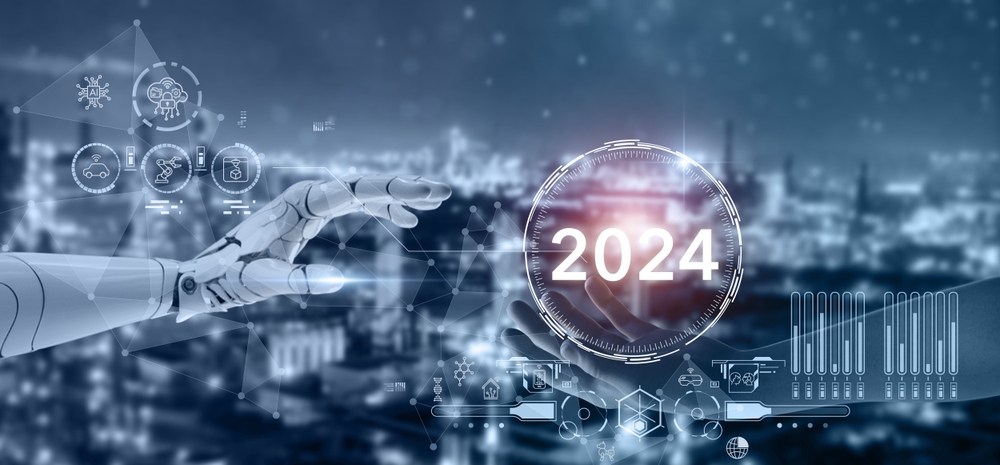In 2024, AI will not only influence the way we work, but its incorporation will also be key in fields such as cybersecurity; and it is also expected to promote greater technological sustainability. This will make it even more essential to work with ethical AI standards that provide trust and avoid risk.
The weight of AI implementations and the adoption of products and services enhanced with this technology will have a greater predominance in IT budgets. For example, IDC predicts that by 2025 G2000 companies will allocate more than 40% of their top IT spending to AI-related initiatives.
The intersection between human capabilities and the inputs of AI will give rise to augmented work, which will increase accuracy and productivity and open up options for creation and innovation.,Generative artificial intelligence (GenAI) will lead to more intelligent applications that will assist people in different routine tasks and will be incorporated into office automation, communication and design tools,This technology will help to organize ideas, summarize content, obtain insights, manage compliance, and schedule and improve the customer experience. It will also facilitate access to large sources of informationand it will allow us to move forward with the automation of other processes.
GenAI and machine learning will help software developers design, code, and test applications, enabling them to respond to the ever-increasing demand for software to solve new business demands.
The consulting firm Forrester anticipates that by 2024 85% of companies will extend AI with open source models, which will not mean the end of proprietary models, but will generate more options to develop generative AI strategies. Gartner, the consulting firm estimates that by 2026 more than 80% of organizations will have used GenAI APIs and models in production environments.
Compliance & Governance
To derive business value from the persistent use of AI, it will be necessary for companies to develop “a disciplined approach to its widespread adoption, along with attention to possible risks.”
Managing the trust, risk, and security of AI will be key in 2024 to avoid potential negative effects that can spiral out of control. Gartner predicts that by 2026, companies that implement a comprehensive AI Trust, Risk, and Security Management (TRiSM) program “will increase the accuracy of their decision-making by eliminating up to 80% of flawed and illegitimate information.”
Regarding the need to mitigate risks and optimize AI governance, 2024 will also see new comprehensive regulations for AI. It is hoped that these regulations on the one hand will “catalyze technological advances and at the same time protect the population from any unintended repercussions of AI.” At the same time, the need for artificial intelligence to operate with maximum transparency and fairness “will require cultivating rigorous standards that ensure responsible management.”
In parallel with these developments, the need to move towards sustainable technology models will become more prevalent in technology-related decisions, and reducing energy consumption will be at the heart of CIOs’ strategies, with green cloud developments and initiatives to reuse heat in data centers.
Immersive Reality and a New Cloud Approach
By 2024, the evolution of virtual and augmented realities will generate increasingly powerful immersive environments that will intertwine the real and virtual worlds in new ways, enabling innovative possibilities for coaching and upskilling, e-commerce, remote collaboration, and entertainment. For example, the consulting firm Statista anticipated that by 2024 the number of users of augmented reality (AR) mobile devices will rise to 1.700 billion worldwide.
With regard to cloud environments, cloud strategies are expected to advance by industry, with services and capabilities customized or adjusted to the specific needs of each industrial sector. It is estimated that by 2027 these initiatives could be chosen by more than 70% of companies.
Ciberseguridad y resiliencia Cybersecurity and Resilience
At the same time, the increase in cyberattacks and the sophistication of cybercrime will lead organizations to design comprehensive business continuity and resilience strategies, which will not only ensure the privacy of customer and employee data and the protection of corporate information, but also guarantee business continuity and recovery from eventual incidents. Gartner anticipates that the continuous threat exposure management (CTEM) approach will prevail, allowing organizations to “assess the accessibility, exposure, and exploitability of physical and digital assets on a continuous and consistent basis.” This consultancy anticipates that by 2026 companies that prioritize their security investments based on a CTEM program “will get a two-thirds reduction in breaches.”
In terms of cybersecurity strategies, AI will also play a central role, allowing suspicious activity to be detected early and cyber defenses to be automated.
The Future of Artificial Intelligence
As you can see, the trends we review will not only represent technological advances, but will also influence aspects of daily life, the way we work and how we interact in society, opening up new challenges, risks and opportunities.
At Baufest, when developing AI solutions, we focus on people and focus on maximizing their potential and making their tasks easier. From our perspective, the technological revolution should serve to empower human beings, not replace them. We are preparing for a 2024 full of interesting projects in which we will be able to deploy our extensive expertise in digital transformation processes and technologies of the future to help companies evolve with an approach that integrates technology and people.

